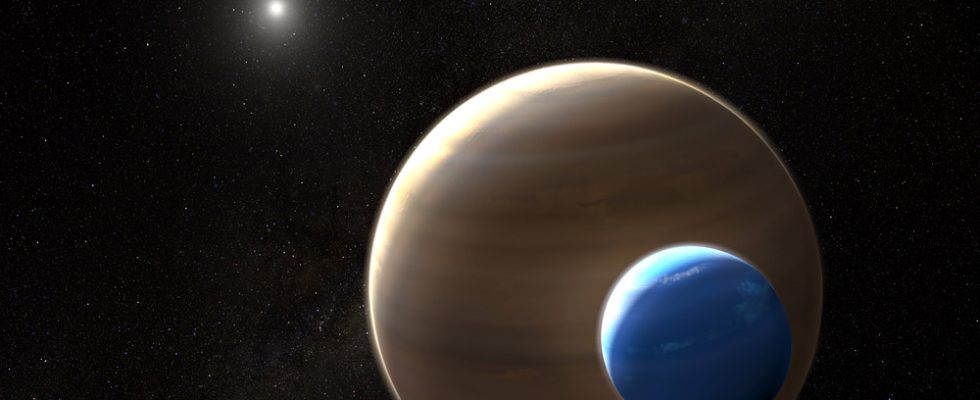Disturbance effect instead of moon? So far, astronomers have discovered two possible exomoons in space – large moons around extrasolar gas giants. But now new analyzes are raising doubts about these findings. The abnormalities detected in the light curves of these systems can also be explained differently, as researchers report in “Nature Astronomy”. Actual exomoons, on the other hand, would have to cause a clearer signal. The first real exomoon could therefore still be waiting to be discovered.
In our solar system, most planets have at least one moon. It therefore stands to reason that many exoplanets also have satellites orbiting them. But detecting such extrasolar moons is extremely difficult. Because of their small size, they only produce a very weak signal that is almost lost in the optical noise when the exoplanet transits in front of its star. It is even more difficult to detect the gravitational influence of such an exomoon on the star.
“Exomoons are so far away that unfortunately they cannot be seen or detected directly, even with powerful telescopes,” explains René Heller from the Max Planck Institute for Solar System Research in Göttingen.
How the two exomoon candidates were discovered
Nevertheless, astronomers led by David Kipping from Columbia University in New York have managed to track down two possible exomoon candidates in recent years. In 2018, they detected a promising signal from the gas giant Kepler 1625b, around 8,000 light-years away, in transit data from the Kepler and Hubble space telescopes. This suggests the presence of a Neptune-sized exomoon in a wide orbit around the exoplanet. In 2022, the team discovered evidence of another exomoon of this size around the exo-Jupiter Kepler-1708b, 5,500 light-years away.
But the additional dimming that these possible exomoons cause in the light curve of their star is so weak that the astronomers were only able to detect it using complex model calculations. To do this, they first created millions of artificial light curves for all conceivable constellations of planets and moons. An algorithm then compares these simulated light curves with the measured curve and looks for the best match. If this corresponds to an exoplanet-exomoon system, this is considered a potential hit.
Astronomical data reviewed
However, analyzes are now raising doubts about the two exomoon candidates. To do this, Heller and his colleague Michael Hippke from the Sonneberg Observatory checked the astronomical data using a newly developed detection algorithm. This program, dubbed “Pandora”, also uses synthetic light curves as a basis for comparison, but is optimized for the search for exomoons and takes into account the latest findings on the physics of three-body systems.
The surprising result: The exomoons around the two extrasolar gas giants are probably not. “We would have liked to confirm the discovery of exomoons around Kepler-1625b and Kepler-1708b,” says Heller. “Unfortunately, our analyzes show something different.” Of the countless possible explanations that the model provided for the anomalies in the light curves, most of them did not involve an exomoon. The slight additional shading can therefore also be caused by natural fluctuations in the brightness of the star, gravitational influences on the planet’s orbit and other disruptive effects.
Signals not clear enough
In the case of the exoplanet Kepler-1708b, the analyzes showed that a moon of the postulated size and orbit would have to leave a stronger, clearer signal in the light curve. In the telescope data, this was only just above the background noise, as the team reports. The testing algorithm classified a moonless planet as almost twelve times more likely than the existence of an exomoon in this system. “This does not rule out the possibility that there is a real exomoon around Kepler-1708b, but it does make it very unlikely,” the astronomers state.
The situation is similar with the exoplanet Kepler-1625b. There are gaps, especially in the data from the Hubble telescope, which make evaluation difficult and potentially lead to falsifications. For example, center-edge obscuration may not have been sufficiently taken into account – the fact that the edge of a star inherently appears darker than its center. Because this also affects the timing and intensity of the transit light curve, it must be factored out. In addition, the signal here is also very weak, as the team explains.
According to astronomers, it is therefore very unlikely that the two exomoon candidates are real. In any case, the data available so far is not sufficient to clearly prove the existence of moons around these two exoplanets, as Heller and Hippke explain.
High false positive rate
In addition, the astronomers’ analyzes showed that exomoon search algorithms often produce false positive results – they “see” a moon where there is none. Specifically, the false positive rate for light curves like Kepler-1626b and Keüpler-1708b was 10.9 and 2.6 percent. “According to our estimates, a false positive finding is not at all surprising, but rather to be expected,” says Heller.
Nevertheless, astronomers see the chance of actually detecting an exomoon as positive. According to their analyses, large exomoons such as those postulated for these two planets should leave a detectable signal in the transit data. “In this sense, the debunked assumptions of Neptune- or super-Earth-sized exomoons around Kepler-1625b and Kepler-1708b could well be harbingers of the first true exomoon discovery,” the team writes. (Nature Astronomy, 2023; doi: 10.1038/s41550-023-02148-w)
Source: Max Planck Institute for Solar System Research
December 11, 2023 – Nadja Podbregar

